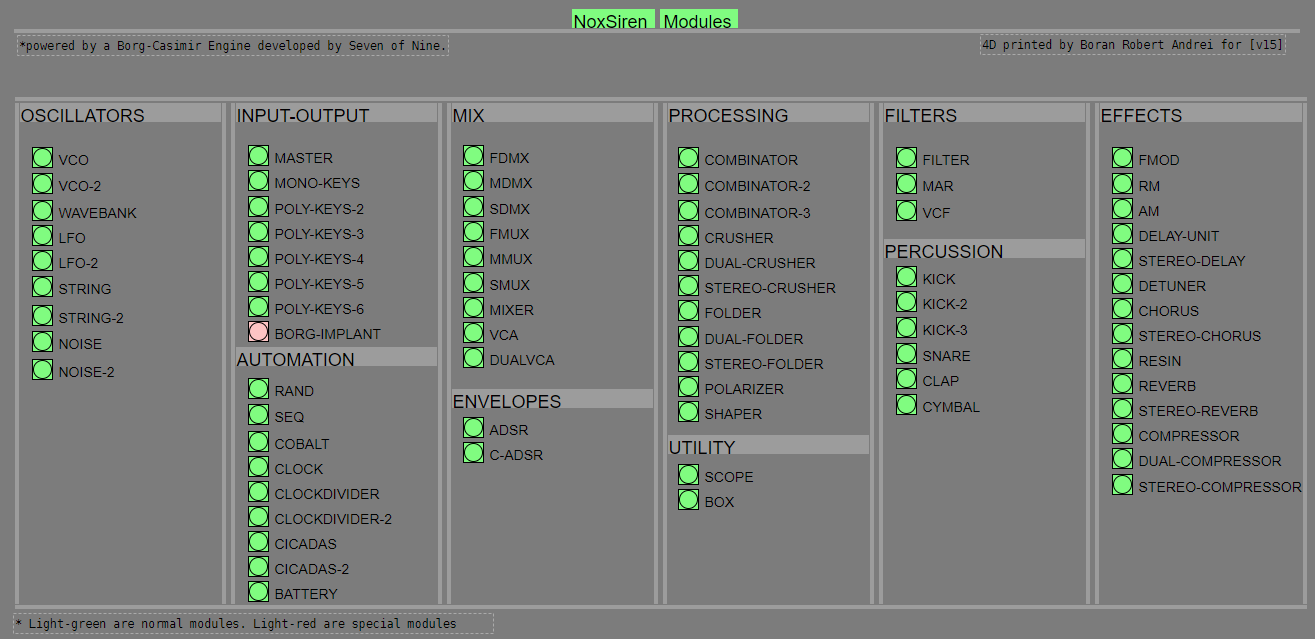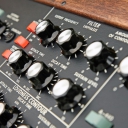ELSE 1.0-0 with Live Electronics Tutorial Release Candidate #9 is out!
Hi! This has gotta be the biggest update ever. geez... there's too much stuff, and I just decided to stop arbitrarily cause there's still lots of stuff to do. Ok, here goes the highlights!
This is the 1st multichannel (MC) aware release of ELSE (so it needs Pd 0.54-0 or later)! There are many many many objects were updated to become MC aware: 42 of them to be exact. There are also many many new objects, and many of them are MC capable, 20 out of 33! Som in total I have 62 objects that deal with MC... that's a good start. More to come later!
Note that 4 of these new ones were just me being lazy and creating new mc oscillators with [clone], I might delete them and just make the original objects MC aware... so basically these new MC objects bring actual new functionalities and many are tools to deal with MC in many ways, like splitting, merging, etc...
With 33 new objects, this is the first release to reach and exceed the mark of 500 externals, what a milestone! (This actually scares me). We now have 509 objects and for the first time ever I have reached the number of examples in the Tutorial, which is also 509 now! But I guess eventually the tutorial will grow larger than the number of externals again...
Since the last release, ELSE comes with an object browser plugin, I have improved it and also included a browser for Vanilla objects. I think it's silly to carry these under ELSE and I hope I can bring this to Vanilla's core. see https://github.com/pure-data/pure-data/pull/1917
A very exciting new object is [sfz~], which is a SFZ player based on 'SFIZZ'. This is more versatile than other externals out there and pretty pretty cool (thanks alex mitchell for the help)!
I have created a rather questionable object called [synth~] which wraps around [clone] and [voices]/[mono], but I think it will be quite interesting to newbies. It loads synth abstractions in a particular template and makes things a bit more convenient. It also allows you to load different abstraction patches with dynamic patching magic.
[plaits~] has been updated to include new 8 synth engines with the latest firmware. Modular people are happy... (thanks amy for doing this)
One cool new object for MC is [voices~], which is a polyphonic voice manager that outputs the different voices in different channels. If you have MC aware oscillators and stuff this allows you to manage polyphonic patches without the need of [clone] at all. This is kinda like VCV works and it opens the door for me to start designing modular inspired abstractions, something I mentioned before and might come next and soon! So much being done, so much to do... What an exciting year for Pd with the incredibly nice MC feature!
There's lots more stuff and details, but I'l just shut up and link to the full changelog here https://github.com/porres/pd-else/releases/tag/v1.0-rc9
You can get ELSE from deken as well. It's up there for macOS, Windows 64 bits, Linux 64 bits and raspberry pi. Please test and tell me if there's something funny.
Cheers!
Chees.
Interviews
Hi, my name is Kane Lister and I am currently studying for my MSc in Audio Engineering and I'm looking to gather some primary research through interviews with members of the PureData community for my case study.
Question will include what different functions do you include in your PureData Synths, what's Synths you like and have you have based any of your synths off of existing synths, etc...
I will be extremely grateful for anyone who participates, thank you.
Basic MIDI setup problem
@JOO What software synth are you using? In my case I think Mohave didn't come with a GM synth installed (like Windows 10 does), so I had to install SimpleSynth and configure it to read from the bus.
I feel so foolish answering Mac set up questions because I'm usually the one asking them  Here is someone who had the same problem 10 years ago: https://forum.pdpatchrepo.info/topic/4119/general-midi-au-dls-synth-where-oh-where
Here is someone who had the same problem 10 years ago: https://forum.pdpatchrepo.info/topic/4119/general-midi-au-dls-synth-where-oh-where
Demonstration of the 5 Basic Synthesizer Modulation Types
UPDATE: 2023-01-11:
I just noticed the zip was missing the needed [sc] abstraction to play the tester. Have updated the zip below to include it. Please, accept my apologies for the deficiency. -PTS-LTM, s
the5basicmodulation-synth-types-2(w-missing-sc).zip
(no other changes)
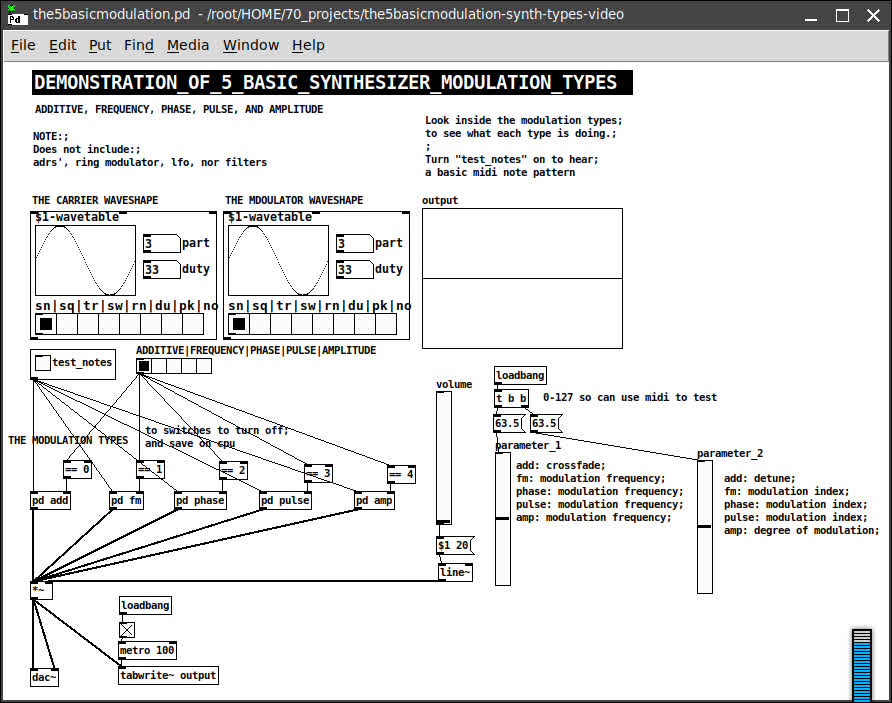
Before I built Jass~(Gemini) I first had to spend a lot of time gathering together all the information I could about all the basic synth types.
This patch consolidates all 5 of the basic types (additive, frequency, phase, pulse, and amplitude) under one heading so that they may be more quickly, easily, and readily comprehended.
It includes selectors for the carrier and modulator wave types, as well as, the two basic controls for each type, and an array so you can both see and hear how those basic types look, feel, and sound.
It's also just sort of cool to listen to.
I hope it may make it easier for you to digest the (what may initially seem complex ideas) more readily and conveniently.
Note: the floss-manuals have a lot to say about it, but leave off some stuff. And the audio-examples -help files are spread out across a lot of space and leave off the viable ranges for each control/parameter.
Good luck! Happy PD-ing. Stay healthy and
Peace through Music and Love through sharing.
p.s. if you find something that is "wrong" about the patches, in terms of how that type of mod is suppose to work, please, let me know, as I did have to guess about a lot of stuff and would love to learn.
How control the same parameter with poly and clone object?
Hi everybody,
I'm trying to build a polyphonic synth which let me control many parameters with midi cc.
First I create a synth. Then I use the object clone to multiply it.
Then I used the objects poly to have many voices of polyphony and it works well, but apparently poly use only note and velocity informations.
So I tried to create a second inlet on my clone object to control one of the synth's parameters. The result seems to be random and it affect only one synth's instances.
I'm blocked at this point.
Can someone show me the way?
Thanks
Paradigms useful for teaching Pd
It's not at all difficult to think of a case where this would break: say, a chord player where the chords may be 3, 4, 5, or 6 notes, to be played as block chords.
In that case the user would just copy-pasta a solution for max = 6 notes, probably with a sentinel value like a negative number to mean "this voice isn't used this time." Ah, I see you mentioned this already. Anyway, the limitation can be abstracted away. That is, the user sends a variable length list <= 6 to the interface, and inside the implementation [unpack] is used to distribute the list to its outlets. The implementation could simply initialize the chord to be all "-1" values, and the incoming list replaces the necessary slots.
Just to spitball-- I think the paradigm of specifying and rigorously testing the max number of "things" is an important and overlooked paradigm for Pd. E.g., if you want to handle up to 6-note polyphony, make an interface that has a slot to specify "6" as the max polyphony in there. Then in the implementation, actually compute the maximum number of things you gave it, and discard the ones you don't need at the last possible moment. (E.g., multiply the signal for that unused voice by "0" before outputting it.)
This way the user will spend all their time testing the maximum amount of time it takes the program to do its work. The user will then get a much better idea of how stable the patch is for realtime use.
If instead you optimize for average use-- say [switch~]ing off unused voices in a piece where you have 4-note polyphony for 15 minutes and 32-note polyphony for 10 seconds-- you do probably 100x fewer tests of the realtime readiness of the 10 seconds of 32-note polyphony. And that's probably the climax of the piece!
Edit: just to be clear-- if you turn on some fancy CPU-hungry filter during the 4-note polyphony and turn it off for the 32-note polyphony, the analysis and design obviously changes.
Routing different signals to clone instances
Hello all!
I’m new to this forum! However I’ve been working with Pd for a while. Currently I’m programming a polyphonic synth in Pd with FM capabilities and I’m facing a problem. I have created some sort of a module which includes one oscillator, a low pass filter and an ADSR envelope generator. The output of this module is an audio signal. It also includes some inputs and one of them is a signal input for frequency modulation (it receives a signal from the outside and uses it to modulate the frequency of the oscillator inside the module). I use clone command to create multiple instances of the same module to make it polyphonic. Then I tried to route a signal from another cloned module to the FM input of the first module and the obvious ocurred: when I play only one note the FM works as supposed to. But when I play multiple notes it sounds terrible and it is because the audio signal of all the notes from the second module goes to the FM input of the first module and then it is routed to all the cloned instances of it. What I need is to route only the signal corresponding to one note and route it to the same note of the first module. Is there any way to achieve this? I understand that a signal goes equally to all instances of a cloned object, but is it possible get separate signals from all instances of the second module and route them separately to the corresponding instances for the first module?
Question about Pure Data and decoding a Dx7 sysex patch file....
Hey Seb!
I appreciate the feedback 
The routing I am not so concerned about, I already made a nice table based preset system, following pretty strict rules for send/recives for parameter values. So in theory I "just" need to get the data into a table. That side of it I am not so concerned about, I am sure I will find a way.
For me it's more the decoding of the sysex string that I need to research and think a lot about. It's a bit more complicated than the sysex I used for Blofeld.
The 32 voice dump confuses me a bit. I mean most single part(not multitimbral) synths has the same parameter settings for all voices, so I think I can probably do with just decoding 1 voice and send that data to all 16 voices of the synth? The only reason I see one would need to send different data to each voice is if the synth is multitimbral and you can use for example voice 1-8 for part 1, 9-16 for part 2, 17-24 for part 3, 24-32 for part 4. As an example....... Then you would need to set different values for the different voices. I have no plan to make it multitimbral, as it's already pretty heavy on the cpu. Or am I misunderstanding what they mean with voices here?
Blofeld:
What I did for Blofeld was to make an editor, so I can control the synth from Pure Data. Blofeld only has 4 knobs, and 100's of parameters for each part.... And there are 16 parts... So thousand + parameters and only 4 knobs....... You get the idea 
It's bit of a nightmare of menu diving, so just wanted to make something a bit more easy editable .
First I simply recorded every single sysex parameter of Blofeld(100's) into Pure data, replaced the parameter value in the parameter value and the channel in the sysex string message with a variable($1+$2), so I can send the data back to Blofeld. I got all parameters working via sysex, but one issue is, that when I change sound/preset in the Pure Data, it sends ALL parameters individually to Blofeld.... Again 100's of parameters sends at once and it does sometimes make Blofeld crash. Still needs a bit of work to be solid and I think learning how to do this decoding/coding of a sysex string can help me get the Blofeld editor working properly too.
I tried several editors for Blofeld, even paid ones and none of them actually works fully they all have different bugs in the parameter assignments or some of them only let's you edit Blofeld in single mode not in multitimbral mode. But good thingis that I actually got ALL parameters working, which is a good start. I just need to find out how to manage the data properly and send it to Blofeld in a manner that does not crash Blofeld, maybe using some smarter approach to sysex.
But anyway, here are some snapshots for the Blofeld editor:
Image of the editor as it is now. Blofeld has is 16 part multitimbral, you chose which part to edit with the top selector:
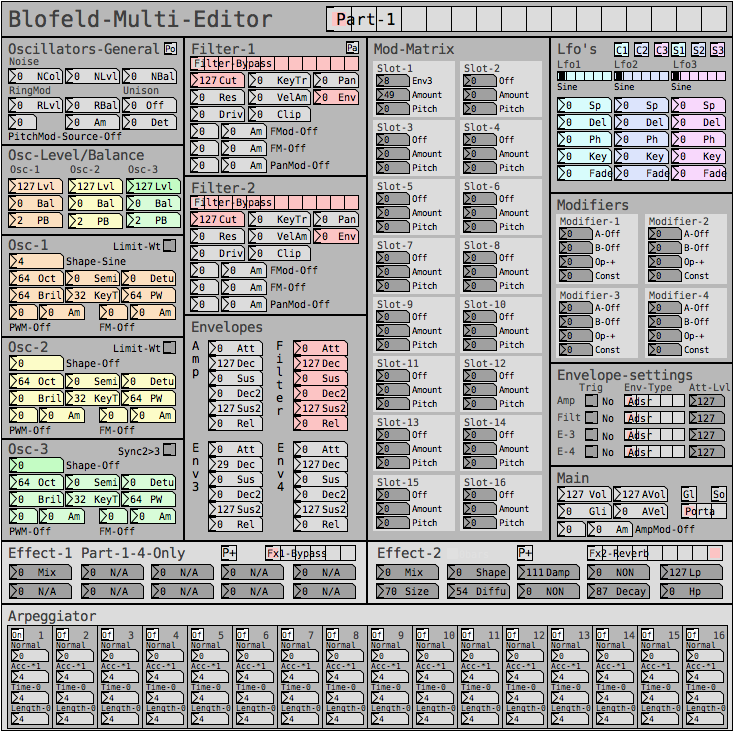
Here is how I send a single sysex parameter to Blofeld:

If I want to request a sysex dump of the current selected sound of Blofeld(sound dump) I can do this:
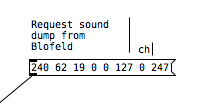
I can then send the sound dump to Blofeld at any times to recall the stored preset. For the sound dump, there are the rules I follow:
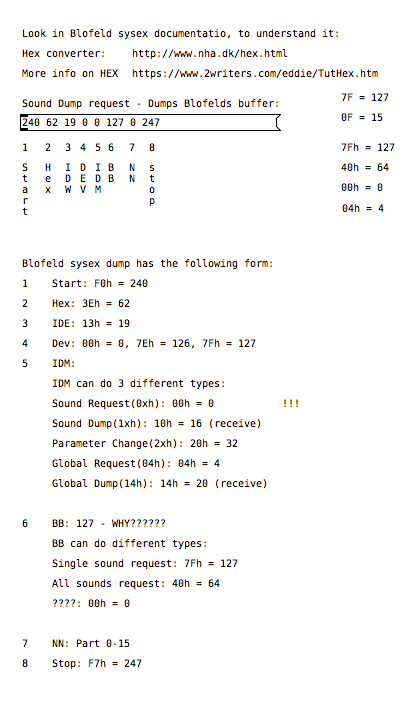
For the parameters it was pretty easy, I could just record one into PD and then replace the parameter and channel values with $1 & $2.
For sound dumps I had to learn a bit more, cause I couldn't just record the dump and replace values, I actually had to understand what I was doing. When you do a sysex sound dump from the Blofeld, it does not actually send back the sysex string to request the sound dump, it only sends the actual sound dump.
I am not really a programmer, so it took a while understanding it. Not saying i fully understand everything but parameters are working, hehe 
So making something in Lua would be a big task, as I don't know Lua at all. I know some C++, from coding Axoloti objects and VCV rack modules, but yeah. It's a hobby/fun thing  I think i would prefer to keep it all in Pure Data, as I know Pure Data decently.
I think i would prefer to keep it all in Pure Data, as I know Pure Data decently.
So I do see this as a long term project, I need to do it in small steps at a time, learn things step by step.
I do appreciate the feedback a lot and it made me think a bit about some things I can try out. So thanks 
Few questions about oversampling
Hi,
About a year ago I started to learn a bit pure data in order to create a patch that would act as a groovebox and that should perform on limited cpu resources since I want it to run on a raspberry pi. First I tried to make somekind of fork of the Martin Brinkmann groovebox patch, even if it allowed me to learn a lot about data flow I didn't went to the core of the patch tweaking with sound generation. This led me to end this attempt at forking MNB groovebox patch because even if I could seperate GUI stuff from sound generation and run it on different thread ect... I couldn't go further in optimization in order to reduce the cpu use.
Then a few weeks ago I decided to start again from scratch my project and this time I wanted to be more patient and learn anything needed in order to be capable of optimizing my patch as much as possible. After making a functional drum machine which runs at 2/3% of cpu with 8 different tracks, 126 steps sequencer, a bit of fx ect... I tried to find synths that would opperate well aside the drum machine. And I basicly didn't find any patch that wouldn't use massive amount of cpu time. So I created my own synths, nothing incredible but I'm happy with what I got, though I noticed some aliasing. I read a bit the floss manual about anti aliasing and apply the method used in the manual(http://write.flossmanuals.net/pure-data/antialiasing/), it work well but my synths almost trippled their cpu use, even if I put all my oscilators in the same subpatch in order to use only one instance of oversampling.
I didn't tried to oversample it less than 16 time but since oversampling is so cpu intensive I'm wondering if there's no other option in order to get a good sound definition at a lower cpu cost. I'm already using banlimited waveform so I don't know what I could do in order to limit the aliasing, especialy for my fm patch where bandlimited waveform isn't very useful in order to reduce aliasing.
Since I want to have at least 4 synth track with some at least one synth having 5 voice polyphony I want to know what the best thing to do. Letting FM aside for this project and use switch~ for oversampling 2 or 4 time my synths that use bandlimited waveform ? Or should I try to run different instances of pd for each synth and controling it from a gui/control patch with netsend(though it wouldn't bring down the cpu use at least it would provide somekind of multithreading for my patch) ? Or is there another way to get some antiliasing ? Or should I review lower my expectation because there is no solution that could provide a decent antialiasing for 4 or more synth running at the same time with a low cpu use in pure data in 2021.
Thanks to everyone that would read my topic and try to give some advice in order to get the best antialising/low cpu use solution.
NoxSiren - Modular synthesizer system <- [v15]
NoxSiren is a modular synthesizer system where the punishment of failure is the beginning of a new invention.
--DOWNLOAD-- NoxSiren for :
-
Pure Data :
NoxSiren v15.rar
NoxSiren v14.rar -
Purr Data :
NoxSiren v15.rar
NoxSiren v14.rar
--DOWNLOAD-- ORCA for :
- x64, OSX, Linux :
https://hundredrabbits.itch.io/orca
In order to connect NoxSiren system to ORCA system you also need a virtual loopback MIDI-ports:
--DOWNLOAD-- loopMIDI for :
- Windows 7 up to Windows 10, 32 and 64 bit :
https://www.tobias-erichsen.de/software/loopmidi.html
#-= Cyber Notes [v15] =-#
- added BORG-IMPLANT module.
- introduction to special modules.
- more system testing.
#-= Special Modules [v15] =-#
- BORG-IMPLANT (connects ORCA MIDI system to NoxSiren system)
#-= Current Modules [v15] =-#
- VCO (voltage-controlled-oscillator)
- VCO2 (advance voltage-controlled-oscillator)
- WAVEBANK (additive synthesis oscillator)
- ADSR (Attack-Decay-Sustain-Release envelope)
- C-ADSR (Curved Attack-Decay-Sustain-Release envelope)
- CICADAS (128 steps-Euclidean rhythm generator)
- CICADAS-2 (advance 128-steps polymorphic-Euclidean rhythm generator)
- COMPRESSOR (lookahead mono compressor unit)
- DUAL-COMPRESSOR (2-channel lookahead mono compressor unit)
- STEREO-COMPRESSOR (lookahead stereo compressor unit)
- MONO-KEYS (virtual 1-voice monophonic MIDI keyboard)
- POLY-KEYS-2 (virtual 2-voice polyphonic MIDI keyboard)
- POLY-KEYS-3 (virtual 3-voice polyphonic MIDI keyboard)
- POLY-KEYS-4 (virtual 4-voice polyphonic MIDI keyboard)
- POLY-KEYS-5 (virtual 5-voice polyphonic MIDI keyboard)
- POLY-KEYS-6 (virtual 6-voice polyphonic MIDI keyboard)
- BATTERY (simple manual triggered machine for drumming.)
- REVERB (reverb unit with lowpass control)
- STEREO-REVERB (stereo reverb unit with lowpass control)
- RESIN (advanced rain effect/texture generator)
- NOISE (generates black,brown,red and orange noise)
- NOISE2 (generates yellow,blue,pink and white noise)
- COBALT (6-stage polyrhythm generator)
- SHAPER (basic shaper unit)
- FOLDER (basic wave folding unit)
- STEREO-FOLDER (stereo wave folding unit)
- DUAL-FOLDER (advance wave folding unit)
- POLARIZER (transform a signal into bi-polar, uni-polar, inverted or inverted uni-polar form)
- CLOCK (generates a BPM clock signal for sequencing other modules)
- CLOCKDIVIDER (a clock divider with even division of clock signal)
- CLOCKDIVIDER2 (a clock divider with odd division of clock signal)
- DELAY-UNIT (delay unit)
- STEREO-DELAY (stereo delay unit)
- CHORUS (chorus unit)
- STEREO-CHORUS (stereo chorus unit)
- SEQ (advance 16-step/trigger sequencer)
- KICK (synthesize kick unit)
- KICK2 (synthesize flavor of KICK module)
- KICK3 (synthesize flavor of KICK module)
- SNARE (synthesize snare unit)
- CLAP (synthesize clap unit)
- CYMBAL (synthesize cymbal unit)
- RAND (RNG generator for other modules parameters)
- FMOD (feedback modulation unit)
- AM (amplitude modulation unit)
- RM (ring modulation unit)
- LFO (low-frequency-oscillator)
- LFO2 (advance low-frequency-oscillator)
- COMBINATOR (combine two waves)
- COMBINATOR2 (combine three waves)
- COMBINATOR3 (combine four waves)
- STRING (Karplus-Strong string synthesis unit)
- STRING2 (advance Karplus-Strong string synthesis unit)
- DETUNER (parametric 4-channel detuner unit)
- CRUSHER (basic audio resolution unit)
- STEREO-CRUSHER (basic stereo audio resolution unit)
- DUAL-CRUSHER (advance audio resolution unit)
- FILTER (basic filter)
- VCF (voltage-controlled-filter)
- MAR (Moog-analog-resonant filter)
- VCA (voltage-controlled-amplifier)
- DUAL-VCA (advance voltage-controlled-amplifier)
- FMUX (multiplexer with fast A/D internal envelope)
- MMUX (multiplexer with medium A/D internal envelope)
- SMUX (multiplexer with slow A/D internal envelope)
- FDMX (demultiplexer with fast A/D internal envelope)
- MDMX (demultiplexer with medium A/D internal envelope)
- SDMX (demultiplexer with slow A/D internal envelope)
- MIXER (mix 1-4 possible waves)
- SCOPE (oscilloscope analyzer)
- MASTER (fancy DAC~)
- BOX (useless decorative module)
NoxSiren integrated modules menu system.
